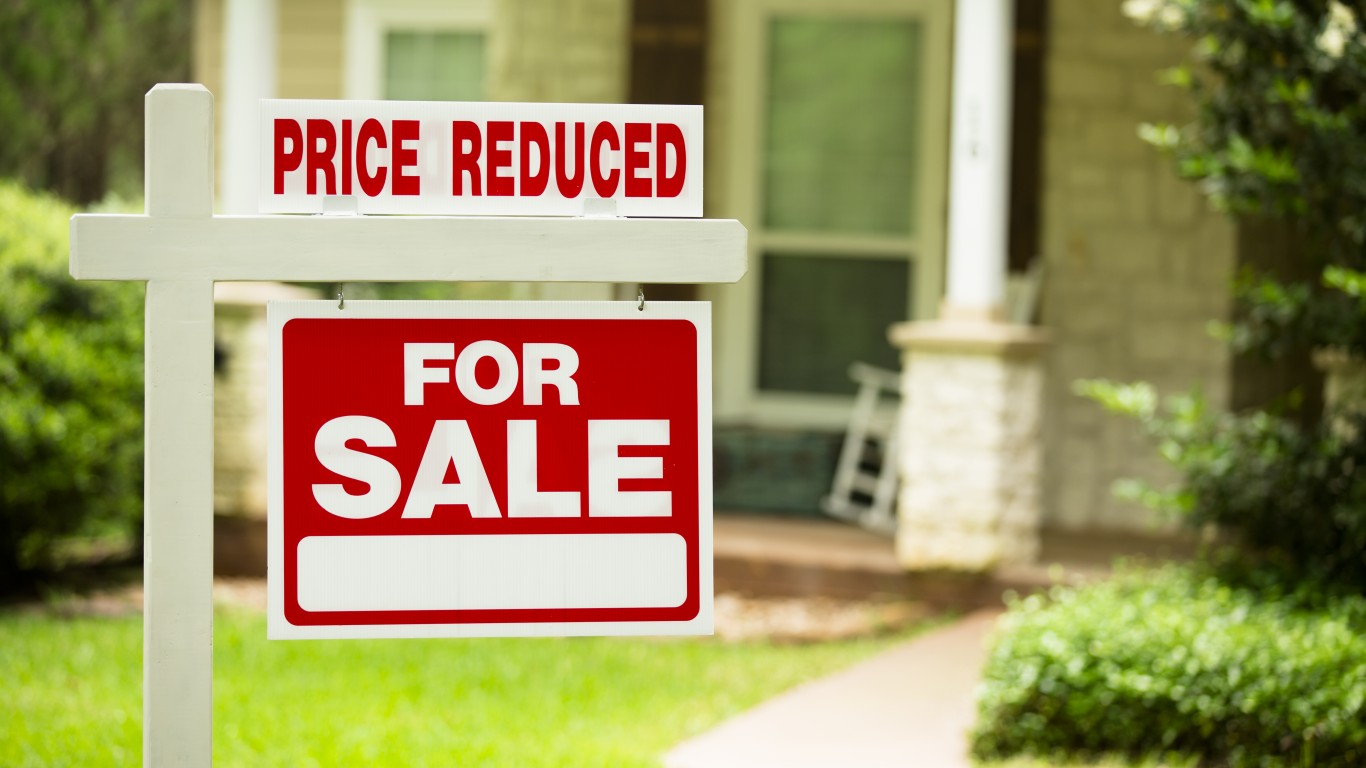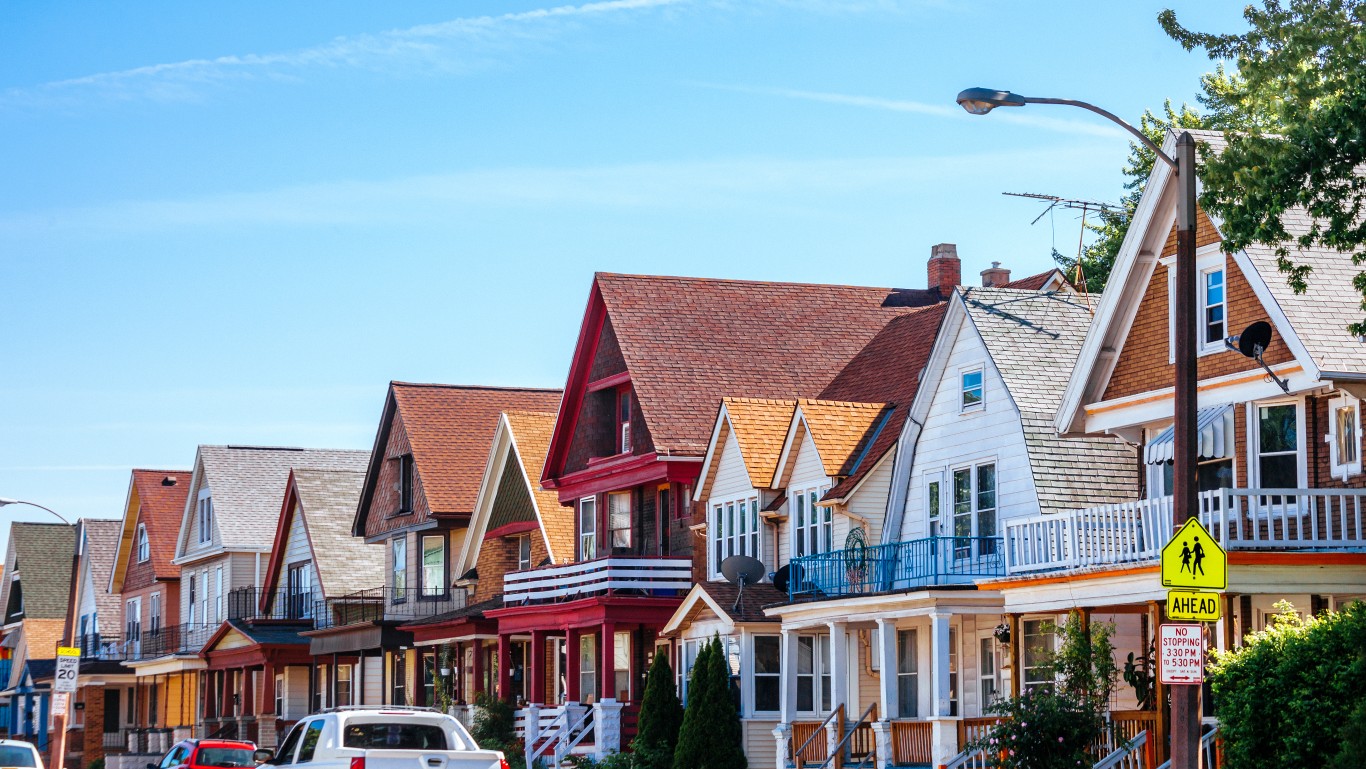 Many Americans are planning to buy homes in the areas that have been hardest-hit by the real estate crisis, according to housing data released today. Real estate research agency Trulia reported that there are a number of major metropolitan areas in the U.S. where people from around the country — many of them retiring baby boomers — are looking for bargains. 24/7 Wall St. has identified the 10 with the highest rate of “inbound” searches.
Many Americans are planning to buy homes in the areas that have been hardest-hit by the real estate crisis, according to housing data released today. Real estate research agency Trulia reported that there are a number of major metropolitan areas in the U.S. where people from around the country — many of them retiring baby boomers — are looking for bargains. 24/7 Wall St. has identified the 10 with the highest rate of “inbound” searches.
Eight out of the 10 areas on our list had a more severe decline in home prices than the U.S. average from pre-recession levels. In six of them, median prices are less than half what they were five years ago. In the Cape Coral-Fort Myers region of Florida, home prices are down nearly 60%.
Dramatic declines in home prices, coupled with rising unemployment, led to a financial crisis for millions of Americans as their homes became worth less than their mortgages. Seven of the 20 regions in the country with the highest rate of underwater mortgages appear on our list.
A consequence has been high foreclosure and vacancy rates. Some areas are still seeing extremely high foreclosure rates, including the Sarasota-Bradenton-Venice area, which had a 57% increase in foreclosures from the second quarter of this year to the third.
The large volume of foreclosures has led to a massive inventory of homes that are now being offered for a fraction of their original prices. “Inventory puts downward pressure on prices,” says Jed Kolko, chief economist at Trulia. According to Kolko, with a huge quantity of foreclosed homes worth very little, the 10 areas on our list will be buyers’ markets for the foreseeable future.
In addition to Trulia’s list of the regions with the highest metro movers score — the ratio of inbound searches to outbound searches — we included former, current and projected home price information from Fiserv, as well as unemployment rates from the Bureau of Labor Statistics. We also included information on underwater mortgages and the percentage of regional sales that have been on formerly foreclosed upon homes from CoreLogic.
These are the 10 metropolitan areas where people want to buy homes:
10. Orlando-Kissimmee-Sanford, Florida
> Metro movers index: 1.87
> Median home price: $142,000
> Home value decline from peak: -53.4%
> Unemployment: 10.2%
> Forecast change in home price through 2Q 2012: -11.4%
Like most of the state of Florida, the Orlando-Kissimmee-Sanford statistical area was hit hard by the housing crisis. More than one in five homes in the region is vacant, and more than half of all owned homes are now worth less than the mortgages on them. Real estate prices have declined 53.4% since the 2006 peak. By the second quarter of next year, Fiserv projects median home values will decline an additional 11.4%. For every person in the region looking for a home elsewhere, 1.87 people are looking at real estate in the area.
9. Las Vegas-Paradise, Nevada
> Metro movers index: 1.88
> Median home price: $135,000
> Home value decline from peak: -59.2% (8th biggest decline)
> Unemployment: 13.6% (13th highest)
> Forecast change in home price through 2Q 2012: -15.9% (2nd biggest decline)
Almost two out of every three homes with a mortgage in the Las Vegas-Paradise metropolitan area is underwater — meaning the home is worth less than the mortgage on it. This is, by far, the highest rate in the country, and it is 10 percentage points greater than the metro area with the second highest rate. Since the first quarter of 2006, the median home value has dropped nearly 60% in this statistical area, and it is expected to drop another 15.9% by the middle of next year. Nearly 40% of the homes sold in the area had previously been foreclosed upon.
8. Oxnard-Thousand Oaks-Ventura, California
> Metro movers index: 1.92
> Median home price: $400,000 (9th highest)
> Home value decline from peak: -39.9%
> Unemployment: 10.1%
> Forecast change in home price through 2Q 2012: -6%
The Oxnard-Thousand Oaks-Ventura area of California forms part of the Los Angeles suburbs, and is one of the wealthier regions in the country. It also features some of the most expensive and desirable retirement homes in the country. The median home value is $400,000 — the ninth-highest in the U.S. But even that high price is nearly 40% down from its peak in the second quarter of 2006. Foreclosures in the region are up 24% from last quarter. Many wealthy individuals close to retirement are looking to this area for second homes at bargain prices.
7. Fort Worth-Arlington, Texas
> Metro movers index: 1.97
> Median home price: n/a
> Home value decline from peak: -5.9%
> Unemployment: 8.3%
> Forecast change in home price through 2Q 2012: +2.7%
Fort Worth is tunlike most of the areas on our list in some key respects. It is the only one of the 10 where home prices are expected to rise by the second quarter of next year, and the only city with an unemployment rate below the national average. The subprime mortgage crisis appears to have completely missed the Fort Worth altogether. Home prices are down just 5.9% from their peak in 2009. According to Trulia, the biggest reason for the high rate of inbound searches is the large number of people looking to move from the nearby city of Dallas.
6. West Palm Beach-Boca Raton, Florida
> Metro movers index: 1.99
> Median home price: $205,000
> Home value decline from peak: -50.2%
> Unemployment: 11.1%
> Forecast change in home price through 2Q 2012: -9.6% (19th biggest decline)
Homes in the West Palm beach area are worth less than half what they were before the recession. Many people have been unable to sell their homes, especially as values are projected by Fiserv to decline an additional 9.6% by the second quarter of 2012. Last year, West Palm Beach had more listings than all but a handful of major U.S. cities. However, inventory will likely be drawn down as foreclosures decline and people begin purchasing dirt-cheap real estate. Nearly one in four of the home sales in the region in the last 12 months was on a formerly foreclosed upon home.
5. Cape Coral-Fort Myers, Florida
> Metro movers index: 2.09
> Median home price: $106,000
> Home value decline from peak: -59.3% (7th biggest drop)
> Unemployment: 11.2%
> Forecast change in home price through 2Q 2012: -12.2% (6th biggest decrease)
There is arguably no single housing market with a worse outlook than southwest Florida, and Cape Coral-Fort Myers is the hardest-hit area. Housing prices here have already dropped 59.3% from their peak, and Fiserv projects a further decline of 12.2% by the second quarter of next year. According to Corelogic, 47% of the homes in the Cape Coral-Fort Myers area are worth less than their mortgages. Foreclosures have increased 35% in the last quarter. However, the long-term outlook may be better than these figures suggest. Real estate agents are giving “foreclosure tours” to show homes that are now worth 40% or less of what they were just five years ago, and the number of people looking for homes in the area is nearly double the number looking to leave.
4. Fort Lauderdale-Pompano Beach, Florida
> Metro movers index: 2.15
> Median home price: $199,000
> Home value decline from peak: -48.4%
> Unemployment: 10.6%
> Forecast change in home price through 2Q 2012: -9.2%
Just five years ago, the median home price in the greater Fort Lauderdale area was nearly $400,000. As of last quarter, it was less than $200,000, and still falling. Prices are projected to fall an additional 9.2% by the middle of next year. The area is, however, one of the most popular retirement destinations in the country, and many see the current lows as an opportunity to purchase a cheap second home.
3. Charleston-North Charleston, South Carolina
> Metro movers index: 2.25
> Median home price: $200,000
> Home value decline from peak: -23.3%
> Unemployment: 9%
> Forecast change in home price through 2Q 2012: -1.6%
The Charleston-North Charleston area saw home prices drop nearly 23% since the 2007 peak. Nearly 10% of homes are vacant — one of the highest rates in the country. Charleston has been, and remains, a popular retirement destination. According to Trulia, most of the people looking at homes in Charleston are from other parts of the state and other southern cities.
2. Riverside-San Bernardino-Ontario, California
> Metro movers index: 4.36
> Median home price: $180,000
> Home value decline from peak: -55.4% (14th biggest decline)
> Unemployment: 13.4% (15th highest)
> Forecast change in home price through 2Q 2012: -14.8% (3rd biggest decline)
This is one of the largest metropolitan statistical areas in the U.S. It also has one of the highest unemployment rates in the country — 13.4%. Poor economic conditions have led to a massive drop of over 55% since home prices peaked in 2006. Prices are projected to fall an additional 14.8% by the second quarter of 2012. The area has had massive foreclosures in the past few years, and nearly 40% of the homes sold in the last 12 months were previously foreclosed upon.
1. North Port-Bradenton-Sarasota, Florida
> Metro movers index: 6.03
> Median home price: $170,000
> Home value decline from peak: -51.4%
> Unemployment: 11%
> Forecast change in Home price through 2Q 2012: -6.5%
Last quarter, the rate of foreclosures in the North Port-Bradenton-Sarasota area jumped 57%, the third-greatest increase in the country. Since the first quarter of 2006, home prices have dropped 51.4%. Foreclosures are likely to increase for some time unless economic conditions improve, as 40.84% of regional homeowners owe more on their mortgages than their homes are worth. Further, prices are expected to drop an additional 6.5% by the second quarter of next year. For every person looking to leave the area, six others are searching for homes here.
Michael B. Sauter
The Average American Is Losing Momentum On Their Savings Every Day (Sponsor)
If you’re like many Americans and keep your money ‘safe’ in a checking or savings account, think again. The average yield on a savings account is a paltry .4%1 today. Checking accounts are even worse.
But there is good news. To win qualified customers, some accounts are paying more than 7x the national average. That’s an incredible way to keep your money safe and earn more at the same time. Our top pick for high yield savings accounts includes other benefits as well. You can earn up to 4.00% with a Checking & Savings Account today Sign up and get up to $300 with direct deposit. No account fees. FDIC Insured.
Click here to see how much more you could be earning on your savings today. It takes just a few minutes to open an account to make your money work for you.
Our top pick for high yield savings accounts includes other benefits as well. You can earn up to 4.00% with a Checking & Savings Account from Sofi. Sign up and get up to $300 with direct deposit. No account fees. FDIC Insured.
Thank you for reading! Have some feedback for us?
Contact the 24/7 Wall St. editorial team.


